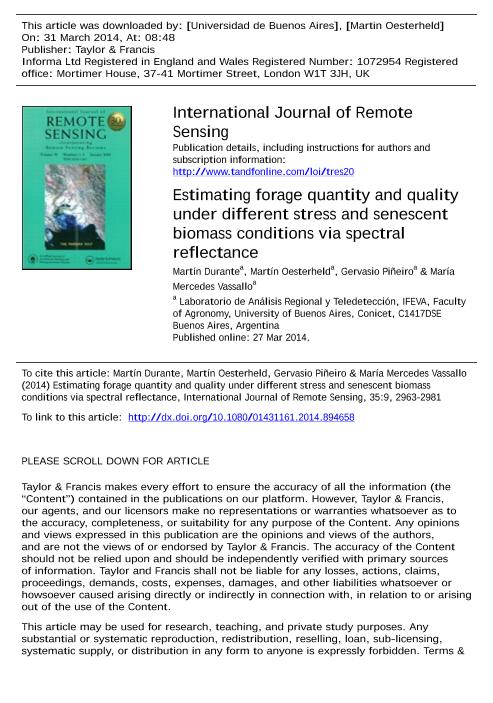Artículo
Estimating forage quantity and quality under different stress and senescent biomass conditions via spectral reflectance
Fecha de publicación:
03/2014
Editorial:
Taylor & Francis
Revista:
International Journal of Remote Sensing
ISSN:
0143-1161
Idioma:
Inglés
Tipo de recurso:
Artículo publicado
Clasificación temática:
Resumen
Assesing forage quantity and quality through remote sensing can facilitate grassland and pasture management. However, the high spatial and temporal variability of canopy conditions may limit the predictive accuracy of models based on reflectance measurements. The objective of this work was to develope this type of models, and to challenge their capacity to predict plant properties under a wide range of environmental conditions. We manipulated Paspalum dilatatum canopies through different stress treatments (flood, drought, nutrient availability, and control) and by artificially varying the amount of senescent biomass. We measured canopy reflectance and constructed simple models, based on either normalized vegetation indices or a few selected wavebands, to estimate biomass and to variables related to forage quality: proportion of photosynthetic vegetation and biomass C:N ratio. General models satisfactorily predicted plants properties for the whole set of environmental conditions, but failed under specific conditions such as drought (for esitmates of plant biomass), fertilization (for estimates of C:N ratio), and different levels of senescent tillers (for estimates of the proportion of photosynthetic vegetation). Where general models failed, specific models, based on different bands, achieved satisfactory accuracy. The generals models performed better when based on a few selected than when based on two-band vegetation indices, having better accuracy (higher R2)and parsimony (lower BIC). However specific models performed similarly for both approaches (similar R2 and BIC). This results indicate that these plant properties can be predicted from reflectance information under a broad range of conditions, but no for some particular conditions, where ancillary data or more complex models are probably needed to increase predictive accuracy.
Palabras clave:
Forage Quantity And Quality
Archivos asociados
Licencia
Identificadores
Colecciones
Articulos(IFEVA)
Articulos de INST.D/INV.FISIOLOGICAS Y ECO.VINCULADAS A L/AGRIC
Articulos de INST.D/INV.FISIOLOGICAS Y ECO.VINCULADAS A L/AGRIC
Citación
Durante, Martín; Oesterheld, Martin; Piñeiro, Gervasio; Vassallo, Maria Mercedes; Estimating forage quantity and quality under different stress and senescent biomass conditions via spectral reflectance; Taylor & Francis; International Journal of Remote Sensing; 35; 9; 3-2014; 2963-2981
Compartir
Altmétricas




